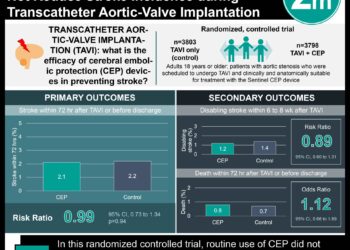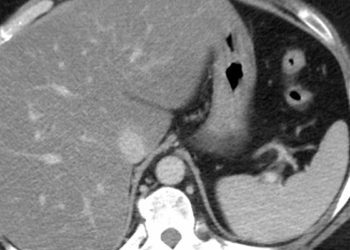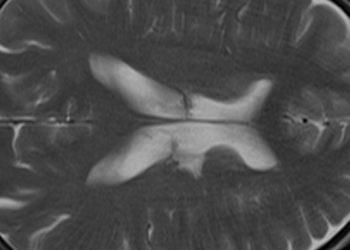2 Minute Medicine Rewind March 23 – March 30, 2015
In this section, we highlight the key high-impact studies, updates, and analyses published in medicine during the past week.
Intracranial stenosis is a common etiology of stroke, often treated with percutaneous transluminal angioplasty and stenting to prevent recurrence. Several studies have looked at the benefits and risks of stenting vs. aggressive medical therapy; the end-points of these studies have consistently shown a greater benefit in stroke reduction with medical therapy over stenting. The VISSIT trial is the first to compare balloon-expendable stent treatment with medical therapy against medical therapy alone in patients with symptomatic intracranial stenosis. In this randomized controlled trial, 112 patients with symptomatic intracranial arterial stenosis were randomized to receive either balloon-expendable stenting plus medical therapy (n=59) or medical therapy alone (n=53). The use of a balloon-expendable stent was associated with increased risk of hemorrhage within 30 days (8.6% vs 0.0%, p = 0.06), an increased 12-month risk of stroke/TIA (36.2% vs. 15.1%, p = 0.02), and worsening of baseline disability scores (24.1% vs 11.3%, p = 0.09). Results were consistent with previous studies, showing that stenting was associated with more negative outcomes than medical therapy alone. Future studies should be done in order to assess whether or not there is a subgroup of patients who may benefit from stenting. This small study was underpowered and it is important to note that investigators were only able to identify consistent trends as opposed to true differences in some of the outcomes. It should also be noted that enrollment in this study was halted early after negative results from a different trial prompted an early analysis of the outcomes.
Screening for Thyroid Dysfunction: U.S. Preventive Services Task Force Recommendation Statement
The American Thyroid Association and the American Association of Clinical Endocrinologists recommend screening for thyroid dysfunction in patients at increased risk for hypothyroidism, and persons over the age of 60 but do not recommend universal screening of non-pregnant, asymptomatic adults. Although early detection of persons with thyroid dysfunction can prevent long-term morbidity and mortality, the risks associated with false positive results can lead to unnecessary testing, over-diagnosis, and overtreatment. In this systematic review, the US Preventative Service Task Force (USPSTF) studied the evidence on the benefits vs. harms of screening asymptomatic adults for subclinical/overt thyroid dysfunction. It was found that there continues to be insufficient evidence to either support or discourage the screening of non-pregnant, asymptomatic adults for thyroid dysfunctions. Despite the reliability of TSH testing, there continues to be a lack of consensus regarding the clinical relevance and appropriate management of asymptomatic adults with abnormal TSH levels. More research into the risks and benefits associated with screening asymptomatic adults for thyroid dysfunction is needed in order to develop clear guidelines regarding the appropriateness of using TSH levels to screen asymptomatic adults for thyroid dysfunction.
Exercise and Vitamin D in Fall Prevention Among Older Women
It is known that falls in the elderly greatly contribute to increased morbidity and mortality. Aside from the risk of serious injury, frequent falls are also associated with decreased independence and poor quality of life. Post-menopausal women are often counseled to supplement with vitamin D in order to strengthen their bones and lower their risk of fragility fractures. Although vitamin D supplementation as a means of preventing bone loss has been well studied, no one has looked into whether or not vitamin D may actually prevent falls in the elderly. In this randomized controlled trial, 409 women between the ages of 70 and 80, were randomized to one of four intervention arms (vitamin D and exercise, placebo and exercise, vitamin D only, and placebo only) to study the effects of exercise and vitamin D on reported and injurious falls. Although vitamin D and exercise had no effect on the rate of falls in the elderly, there was a 50% reduction in the number of injurious falls among exercisers with vitamin D (HR 0.38, 95% CI 0.17-0.83) and in exercisers without vitamin D (HR 0.47, 95% CI 0.23-0.99) suggesting an important role for exercise in injurious fall prevention amongst elderly women. Future studies should seek to identify whether or not exercise has a similar effect on elderly men.
Transfusion of red blood cells is often used to treat hemorrhage and/or anemia in a variety of hospitalized patients with simple and complex medical problems. The benefits and harms of restrictive vs. liberal transfusion strategies have long been debated and several randomized controlled trials have looked at the outcomes of different transfusions strategies in particular patient populations. Recent randomized controlled trials have favored restrictive transfusion strategies, suggesting potential harm with liberal transfusion strategies. In this systemic review, investigators analyzed 31 trials (totaling 9813 randomized patients) by looking at Cochrane central register of controlled trials, SilverPlatter Medline, SilverPlatter Embase, and Science Citation Index Expanded. It was found that restrictive transfusion strategies were associated with a reduction in the number of units transfused (mean difference 1.43, 95% CI -2.01 to -0.86, p < 0.001) and the number of patients requiring red blood cell transfusions (RR 0.54, 95% CI 0.47-0.63, p < 0.001). There was no significant difference between the restrictive and liberal transfusion strategies with respect to morbidity (RR 0.98, 95% CI 0.85-1.12, p = 0.75), mortality (RR 0.86, 95% CI 0.74-1.01, p = 0.07), and myocardial infarction (RR 1.28, 95% CI 0.66-2.49, p = 0.46). Whether or not the overall use of red blood cell transfusion should be guided by restrictive or liberal transfusion strategies is still up for discussion and although restrictive transfusion strategies seem to be associated with less harm, certain patient populations may require more liberal transfusion strategies.
Aflibercept, Bevacizumab, or Ranibizumab for Diabetic Macular Edema
Despite increased efforts towards monitoring persons with diabetes for the micro- and macro- vascular complications associated with the disease, diabetes remains the leading cause of new blindness in the United States. Macular edema contributes greatly to the vision loss associated with diabetes and improved treatment options are of continual importance. Laser photocoagulation and intravitreal treatments are the primary treatment options for the majority of persons with varying degrees of vision loss secondary to diabetic macular edema. In this randomized controlled, 660 adults with diabetic macular edema involving the macular center were randomized to one of three treatment arms (intravitreous aflibercept, intravitreous bevacizumab, intravitreous ranibizumab) to compare the mean change in visual acuity at 1 year with the different intravitreal anti-VGEF agents. Intravitreous aflibercept was more effective at improving vision in study participants with severe loss of visual acuity, which was defined by a baseline visual acuity score of less than 69 (20/50 vision or worse). In these patients, visual acuity improved by 18.9 with aflibercept, by 11.8 with bevacizumab, and by 14.2 with ranibizumab (p < 0.001 for aflibercept vs. bevacizumab, p = 0.003 for aflibercept vs. ranibizumab, and p = 0.21 for ranibizumab vs. bevacizumab). When the initial visual acuity loss was mild (baseline visual acuity score 69-78), there was no statistically significant difference amongst the three study groups (mean improvement was 8.0 with aflibercept, 7.5 with bevacizumab, 8.3 with ranibizumab; p > 0.50 for each pairwise comparison). Further research should focus on comparing outcomes between intravitreal anti-VGEF agents (aflibercept, bevacizumab, ranibizumab) and intravitreal corticosteroids (triamcinolone, dexamethasone, fluocinolone).
Image: PD
©2015 2 Minute Medicine, Inc. All rights reserved. No works may be reproduced without expressed written consent from 2 Minute Medicine, Inc. Inquire about licensing here. No article should be construed as medical advice and is not intended as such by the authors or by 2 Minute Medicine, Inc.







